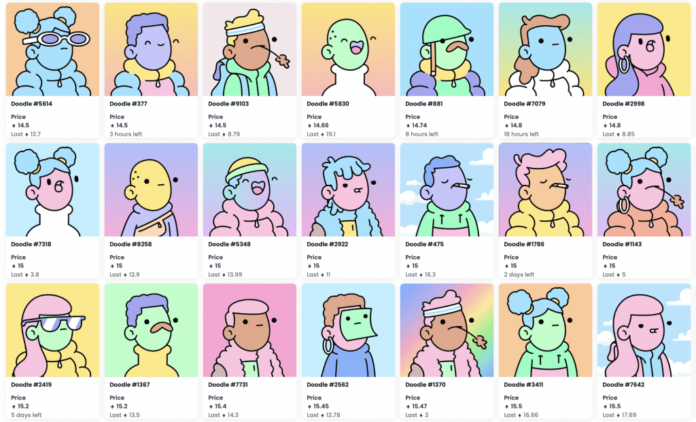The U.S. Copyright Office and the U.S. Patent and Trademark Office (“USPTO”) confirmed that they will carry out a joint effort to address issues related to non-fungible tokens (“NFTs”) amid rising questions – and legal disputes – centering on the novel technology. News of the impending intellectual property and NFT-centric study follows from a formal request from Senators Patrick Leahy and Thom Tillis, who respectively serve as the Chairman and Ranking Member of the Judiciary Subcommittee on Intellectual Property, that the two offices address undertake a joint effort to help the Subcommittee to understand “how NFTs fit into the world of intellectual property rights,” including what those rights look like today and how they may evolve in the future.
In a letter to USPTO Under Secretary of Commerce Kathi Vidal and the Copyright Office Director Shira Perlmutter dated June 9, Senators Leahy and Tillis stated that “NFTs are already in global use today and their adoption continues to grow since their relatively recent introduction,” with NFTs being “found in nearly all spheres – from academia to entertainment to medicine, art, and beyond.” Against this background, the Senators set out a list of “non-exhaustive considerations” that they requested the USPTO and the Copyright Office address, including …
(1) What are the current applications of NFTs and their respective IP and IP-related challenges?
(2) What potential future applications of NFTs do you foresee and what are their respective potential IP challenges?
(3) For current and potential future applications of NFTs:
– How do transfers of rights apply? How does the transfer of an NFT impact the IP rights in the associated asset?
– How do licensing rights apply? Can and how can IP rights in the associated asset be licensed in an NFT context?
– In what way does infringement apply? What is the potential infringement analysis where an NFT is associated with an asset covered by third party IP? Or where the underlying asset associated with an NFT is owned by the NFT creator and infringed by another?
– What intellectual property protection can be afforded? What IP protection can be afforded to the NFT creator? What if the NFT creator is a different person or entity from the creator of the associated asset?
– How else does 17 U.S.C. § 106 apply?
(4) What are current and potential future uses, internal and external to your agencies, for using NFTs to secure and manage IP rights?
(5) How do current statutory protections for copyright, such as the DMCA, apply to NFT marketplaces and are those protections adequate to address current infringement concerns?
The Senators requested that the USPTO and Copyright Office complete the study by July 2023, which likely means that there very well “may be market-driven answers to many of these questions before the study is published,” according to Proskauer partners Jeffrey Neuburger and Wai Choy, who point to the “pace of innovation in the NFT and crypto space and the current crop of active litigations concerning IP issues and NFTs.” More than that, they note that “as technology, creativity and business models continue to evolve at an incredibly rapid pace, there will likely be new issues to consider” by this time next year.
To date, a growing number of cases that center on NFTs are increasingly shedding light on the “respective IP and IP-related challenges” at play in this space – from questions of whether alleged trademark infringements stemming from the use of NFTs as “receipts” for physical goods can be shielded by the first sale doctrine and/or nominative fair use (one of the issues on the Nike v. StockX case) to those that ask whether the copyright in a major film is infringed by the offering up of NFTs tied to uncut scenes(this is at issue in the Miramax v. Tarantino case, which, more specifically, asks whether Tarantino’s reserved right to screenplay publication extends to Pulp Fiction-centric NFTs) – thereby, answering at least some of the Senators’ first question.
At the same time, courts, trademark offices, and regulators, alike, have started to provide some high-level insight into how they view NFTs. In an order in May, in which he denied MetaBirkins creator Mason Rothschild’s motion to dismiss the case that Hermès filed against him, Judge Jed Rakoff of the U.S. District Court for the Southern District of New York shed light on how NFTs should be construed, describing NFTs as “units of data stored on a blockchain that are created to transfer ownership of either physical things or digital media.” While an NFT can be associated with either digital and physical assets, the judge stated that those assets “are stored” – and ultimately, exist – “separately” from the digital tokens, themselves.
In that same order, in refusing to toss out Hermes trademark infringement and dilution claims, the judge seems to suggest that the trademark rights that brands have amassed for use on purely physical goods could very well extend into the metaverse and allow for claims in the event that the assets tied to the NFTs – or potentially, just virtual goods themselves that are not tied to NFTs at all – are capable of functioning in the metaverse. (As we wrote last month, Hermès has not yet made use of the protected Birkin name or trade dress in connection with any virtual products or NFTs, but that seemingly does not stop its existing “real” world rights from extending into the virtual world.)
In terms of issues involving NFTs and the Digital Millennium Copyright Act, at a baseline level, Skadden’s Stuart Levi, MacKinzie Neal, and Anita Oh state that “the application of the DMCA to NFT marketplaces is straightforward: NFT marketplaces can take advantage of the DMCA safe harbor by describing how a copyright owner can submit a DMCA takedown notice, and then implementing that process, including by allowing the individual or entity listing an NFT to provide a counter notification through which they can assert their own rights.”
Matters are complicated, of course, by the fact that NFTs, themselves, do not consist of digital art or other assets; NFTs are digital tokens that may “point to a copy somewhere off-chain on the internet (e.g., on a server),” per Proskauer’s Peter Cramer and David Munkittrick. “For a content creator who discovers a counterfeit NFT of his or her art, this means that notice-and-takedown is mostly limited to targeting and removing that NFT’s marketplace listing (that is, the specific Web 2.0 page at which the NFT is offered for sale and the associated art is displayed), but leaving the technically non-infringing token, itself, undisturbed on its blockchain, continuing to point anyone who accesses it to the off-chain unauthorized copy of the art.” (This reality speaks to the Senators’ inquiry about how current protections for copyright, such as the DMCA, apply to NFT marketplaces and are those protections adequate to address current infringement concerns.)
Finally, while the Senators rightly note the rise in popularity and use of such tokens across industries, the state of the NFT market, more broadly, is not necessarily so straightforward. “It is difficult to get an accurate pulse on NFT markets,” Amy Castor wrote for Art News this spring, stating that “reports tend to be inconsistent” and “most of the data on NFTs comes from the platforms themselves,” with no way of really gauging whether trading volume is legitimate or the result of wash trading, an illegal stock trading practice in which “users buy and sell the same item to themselves as a way to artificially inflate numbers.”
Credit: Source link






















 Bitcoin
Bitcoin  Ethereum
Ethereum  Tether
Tether  Solana
Solana  USDC
USDC  Lido Staked Ether
Lido Staked Ether  XRP
XRP  Dogecoin
Dogecoin  Toncoin
Toncoin  Cardano
Cardano  Shiba Inu
Shiba Inu  Avalanche
Avalanche  Wrapped Bitcoin
Wrapped Bitcoin  Bitcoin Cash
Bitcoin Cash  TRON
TRON  Polkadot
Polkadot  Chainlink
Chainlink  Internet Computer
Internet Computer  Polygon
Polygon  Litecoin
Litecoin  NEAR Protocol
NEAR Protocol  Uniswap
Uniswap  LEO Token
LEO Token  Dai
Dai  Aptos
Aptos  Ethereum Classic
Ethereum Classic  Mantle
Mantle  Stacks
Stacks  First Digital USD
First Digital USD  Filecoin
Filecoin  Cronos
Cronos  OKB
OKB  Stellar
Stellar  Cosmos Hub
Cosmos Hub  Render
Render  Renzo Restaked ETH
Renzo Restaked ETH  Arbitrum
Arbitrum  Immutable
Immutable  Bittensor
Bittensor  Hedera
Hedera  Maker
Maker  dogwifhat
dogwifhat  The Graph
The Graph  Injective
Injective  Optimism
Optimism  Ethena USDe
Ethena USDe  Fetch.ai
Fetch.ai 
